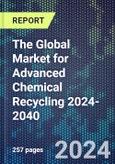Advanced recycling technologies that utilize heat or chemical solvents to recycle plastics into new plastics, fuels or chemicals are a key strategy for solving the global plastic problem, and are priority areas in government green initiatives. Advanced chemical recycling technologies are now being developed by more than 150 companies worldwide, and capacities are increasing. Companies including ExxonMobil, New Hope Energy, Nexus Circular, Eastman, Encina are planning to build large plastics recycling plants. As well as complementing traditional mechanical recycling, advanced recycling offers benefits such as widening the range of recyclable plastic options, producing high value plastics (e.g. for flexible food packaging) and improving sustainability (using waste rather than fossil fuels for plastics production).
The Global Market for Advanced Chemical Recycling 2024-2040 provides a comprehensive analysis of the global advanced chemical recycling technologies market. The report covers market drivers, trends, industry developments, capacities, polymer demand forecasts segmented by recycling technology, regional demand forecasts, product examples, value chain analysis, life cycle assessments, yields, pricing, and challenges. 160 companies active in advanced recycling technologies such as pyrolysis, gasification, dissolution, depolymerization, and more are profiled. Detailed technology overviews, SWOT analyses, and company capacity details are also provided.
Regional market demand forecasts are broken down by recycling technology for Europe, North America, South America, Asia, Oceania, and Africa. Polymer-specific demand forecasts are provided globally and by region for PE, PP, PET, PS, nylon and other polymers. The report analyses how virgin plastic production, mechanical recycling, pyrolysis, monomer recycling and other technologies will shape polymer demand.
The report provides unique insights into the market future, current capacities, life cycle assessments, products, and opportunities in advanced chemical recycling. It is designed for companies in the plastics value chain seeking detailed analysis on growth opportunities, partnerships, investment, positioning, and challenges.
Report contents include:
- Overview of the global plastics and bioplastics markets
- Market drivers and trends
- Advanced chemical recycling industry news, funding and developments 2020-2023
- Capacities by technology
- Market maps and value chain
- In-depth analysis of advanced chemical recycling technologies
- Global polymer demand 2018-2040, segmented by technology, types and regions, million metric tons
- Global demand by recycling process, 2018-2040, million metric tons
- Advanced chemical recycling technologies covered include:
- Pyrolysis
- Gasification
- Dissolution
- Depolymerisation
- Emerging technologies
- Profiles of 161 companies. Companies profiled include Agilyx, APK AG, Aquafil, Carbios, Eastman, Extracthive, Fych Technologies, Garbo, gr3n SA, Hyundai Chemical Ioniqa, Itero, Licella, Mura Technology, revalyu Resources GmbH, Plastogaz SA, Plastic Energy, Polystyvert, Pyrowave, RePEaT Co., Ltd., Synova and SABIC (full list of companies profiled in table of contents).
This product will be delivered within 1-3 business days.
Table of Contents
1 CLASSIFICATION OF RECYCLING TECHNOLOGIES2 RESEARCH METHODOLOGY
Companies Mentioned (Partial List)
A selection of companies mentioned in this report includes, but is not limited to:
- Aduro Clean Technologies, Inc
- Agilyx
- Alpha Recyclage Composites
- Alterra Energy
- Ambercycle, Inc
- Anellotech, Inc
- Anhui Oursun Resource Technology Co., Ltd
- APChemi Pvt. Ltd
- APK AG
- Aquafil S.p.A
- ARCUS Greencycling GmbH
- Arkema
- Axens SA
- BASF
- Bcircular
- BioBTX B.V
- Biofabrik Technologies GmbH
- Blest (Microengineer Co., Ltd.)
- Blue Cycle
- BlueAlp Technology
- Borealis AG
- Boston Materials LLC
- Braven Environmental, LLC
- Brightmark
- Cadel Deinking S.L
- Carbios
- Carboliq GmbH
- Carbon Fiber Recycling LLC
- Cassandra Oil AB
- Chevron Phillips Chemical
- Chian Tianying
- CIRC
- Clariter
- Clean Planet Energy
- Corsair Group International
- Covestro
- CreaCycle GmbH
- CuRe Technology BV
- Cyclic Materials
- DePoly SA
- Dow Chemical Company
- DyeRecycle
- Eastman Chemical Company
- Eco Fuel Technology, Inc
- Ecopek S.A
- Eeden GmbH
- Emery Oleochemicals
- Encina Development Group, LLC
- Enerkem, Inc
- Enval
- Environmental Solutions (Asia) Pte Ltd
- Epoch Biodesign
- Equipolymers GmbH
- Evonik Industries AG
- Evrnu
- Extracthive
- ExxonMobil
- Fairmat
- Fulcrum BioEnergy
- Futerro
- Fych Technologies
- Garbo S.r.l
- Gr3n SA
- GreenMantra Technologies
- Handerek Technologies
- Hanwha Solutions
- Honeywell
- Hyundai Chemical
- Indaver nv
- InEnTec, Inc
- INEOS Styrolution
- Infinited Fiber Company Oy
- Ioncell Oy
- Ioniqa Technologies B.V
- Itero Technologies
- Jeplan, Inc
- JFE Chemical Corporation
- Kaneka Corporation
- Khepra
- Klean Industries
- Lanzatech
- Loop Industries, Inc
- LOTTE Chemical
- Lummus Technology LLC
- LyondellBasell Industries Holdings B.V
- Metaspectral
- Microwave Chemical Co. Ltd
- Mint Innovation
- Mitsubishi Chemical
- MolyWorks Materials
- Mote, Inc
- Mura Technology
- Nanya Plastics Corporation
- NatureWorks
- Neste Oyj
- New Hope Energy
- Next Generation Group (NGR)
- Nexus Circular LLC
- Novoloop
- Olefy Technologies
- Orlen Unipetrol Rpa S.r.o
- PETRONAS Chemicals Group Berhad
- Plastic Back
- Plastic Energy Limited
- Plastic2Oil, Inc
- Plastogaz SA
- Poliloop
- Polycycl
- Polynate
- PolyStyreneLoop
- Polystyvert, Inc
- Poseidon Plastics
- Premirr Plastics, Inc
- Protein Evolution
- Pryme BV
- PureCycle Technologies
- Pyrowave
- Qairos Energies
- QuantaFuel ASA
- Re:newcell
- Recenso GmbH
- Recyc’ELIT
- ReNew ELP
- Renew One
- RePEaT Co., Ltd
- Repsol
- Resiclo Oy
- revalyu Resources GmbH
- ReVital Polymers, Inc
- Rittec Umwelttechnik GmbH
- Sabic
- Samsara Eco Pty Ltd
- Saperatec GmbH
- SCG Chemicals
- Scindo
- Sekisui Chemical Co., Ltd
- Shell
- Showa Denko K.K
- Shuye Environmental Technology
- Sierra Energy
- SK Global Chemical Co., Ltd
- Sulzer Chemtech AG
- Sumitomo Chemical
- Sweet Gazoil
- Synova
- Synpet Technologies
- Technisoil Industrial
- Teijin Frontier Co., Ltd
- TotalEnergies
- Toyo Styrene Co., Ltd
- Trinseo
- Triple Helix
- Uflex
- Valoren
- Vartega Inc
- Velocys
- Versalis SpA
- Wastefront
- Worn Again Technologies
- Xycle
- Österreichische Mineralölverwaltung (OMV)
Methodology

LOADING...








